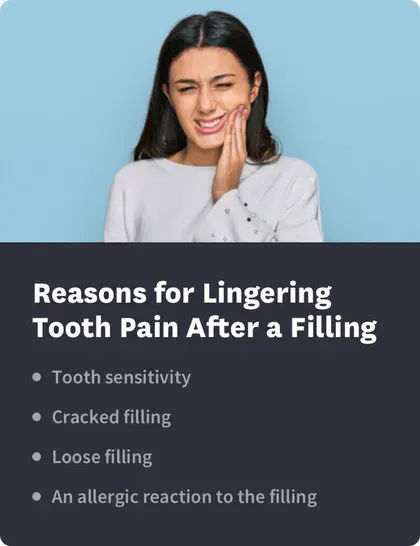Lingering Tooth Pain Weeks After a Filling: Is This Normal?

Table of Contents
- Tooth Pain Proceeding a Filling
- Reasons for Lingering Tooth Pain
- Treating Pain After a Filling
- When You Should See Your Dentist
- References
Tooth pain in the first day or two after getting a filling is normal, but this pain should ease after about two days. If it does not go away — if it lingers or gets worse — return to your dentist for help.
There are several reasons that your filling might cause pain, often because it is cracked or ill-fitting, which your dentist can fix.
Is Tooth Pain After a Filling Normal?
Experiencing pain, swelling, and bleeding can all be signs that you have a cavity in a tooth that needs a filling. Pain before getting a filling is normal, and getting a filling should eventually solve the pain.
However, you might experience pain after getting a filling, which can indicate that there is another problem. Pain after the first day or two is normal, but ongoing or worsening pain means you should go back to your dentist.
Reasons for Lingering Tooth Pain After a Filling
You might develop tooth pain after getting a filling due to:

Hot, cold, and sweet food can all cause some dental sensitivity and even pain as a reaction. These sensations might be heightened after you get a filling. Air temperature and pressure from biting down can also cause pain on a new filling.
Typically, this pain and sensitivity should go away within a few weeks. If it does not go away or if it gets worse, contact your dentist.
If the filling material is delicate or you bite down on something very hard, you might crack your filling, which can cause pain. Cracked fillings might also allow bacteria to get into the center of your tooth or into the root, leading to further decay and even gum disease. Cracks may form in fillings over time too.
If the filling does not fit properly in your tooth, it can rub against the dentin and the root, causing irritation. The area may also allow infection to take hold or spread. Your dentist can fix a filling that does not fit properly.
Most materials used in dental fillings are nonreactive, but it is possible to have an allergic reaction to some of the materials used, which can cause pain, inflammation, and bleeding. There may be other symptoms like feeling tired, developing a local rash near the filling, or itching. If you know you are allergic to certain materials like silver, be sure to tell your dentist.
Some pain or sensitivity immediately after getting a feeling is normal, and taking over-the-counter pain medications can ease that pain. If the pain does not get better, gets worse, or is accompanied by other problems like a fever, bleeding, or inflammation, get help from your dentist immediately.
A lingering discomfort after a filling will typically resolve without the need for any special treatment within a few days but usually not longer than a week or two.
Treating Tooth Pain Immediately After a Filling
In the first few days after getting a filling, topical anesthetic or over-the-counter painkillers can ease pain you experience. You may also consider:
Using a toothbrush for sensitive teeth, which will have softer bristles.
Brushing more gently than you normally do, especially around the tooth with the new filling.
Avoiding foods that might cause pain or sensitivity, like very hot or cold foods, crunchy food, acidic foods, or sugary food.
Rinsing the mouth with warm saltwater after brushing and flossing.
Continued or worsening pain means you should contact your dentist to check the filling. While you wait, over-the-counter pain medications, along with cold compresses, can lessen your discomfort.
When You Should Return to Your Dentist
When you return to your dentist to check the filling, your dentist may find that there is a malocclusion of the filling. This means it might be too high, and your dentist can adjust the filling so there is less pressure and discomfort. Your dentist may also need to replace the filling with a different material. For some people, composite fillings can increase pain or sensitivity.
There may be inflamed roots or pulp causing the pain or discomfort, which either appeared after the filling or were not removed because your dentist did not notice them at first. Unfortunately, extensive decay or infection may mean you need a root canal or an extraction.
Fortunately, pain after getting a filling is rare. Most people recover quickly and experience satisfaction with their treatment.
